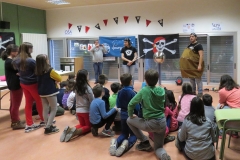 The main aim of A pirates’ world was to show physics to kids in a way they can enjoy.
The main aim of A pirates’ world was to show physics to kids in a way they can enjoy.
This activity has been carried out at five different schools in Valladolid city and its surroundings:
– CEIP Ana de Austria (Cigales, Valladolid) on January 26th, 2016
– Colegio La Milagrosa y Santa Florentina (Valladolid) on January 26th, 2016
– CEIP Francisco Pino (Valladolid) on February 12th, 2016
– Colegio La Inmaculada M.S.J.O (Valladolid) on February 19th, 2016
– Colegio Virgen Niña (Valladolid) on April 22nd, 2016
The activity consisted of two different workshops of around 25 minutes long, which are carried out at the same time, and both set in a pirate’s ambience. Every group of kids was in the activity for around 50 minutes. We received 6 different groups at each school. The total audience of this activity was around 750 kids in the mentioned five elementary schools. The total length of this activity is around 2 hours.
The following concepts were dealt:
- Parabolic motion. With a homemade cannon that allows three possible initial angles, it was shown that the maximum horizontal distance is reached for an angle of 45º.
- Compass. The concept of magnetic field was introduced in an easy way, and the interaction with magnets was shown.
- Optics. A homemade telescope was explained to the kids.
- Density. This concept was explained through two different experiments. A ‘liquid tower’ was built using liquids with different densities (and colors): soap, water, oil, and alcohol. This tower was given as a present for each class. In the second experiment, ships made of play-doh helped to explain how ships can float. A solid sphere and a boat- shaped object were compared, even including more weight in the second.
- Luminescence. It was explained that some natural materials could absorb light of some ’colour’ and emit light of a different ‘colour’.
- Introduction to electricity phenomena occurring in boats (e.g., St. Elmo’s Fire) using a Van der Graaf generator.
- Other experiments carried out were: invisibility under water (refractive index), fire and Leidenfrost effect; air vortex; among others.
The feedback given by the students and teachers was really good and this activity will continue to be offered to schools in the region and hopefully will be done other times this year.
 Check this video activity on Youtube! Check this video activity on Youtube! |
 More photos on our Facebook album! More photos on our Facebook album! |
